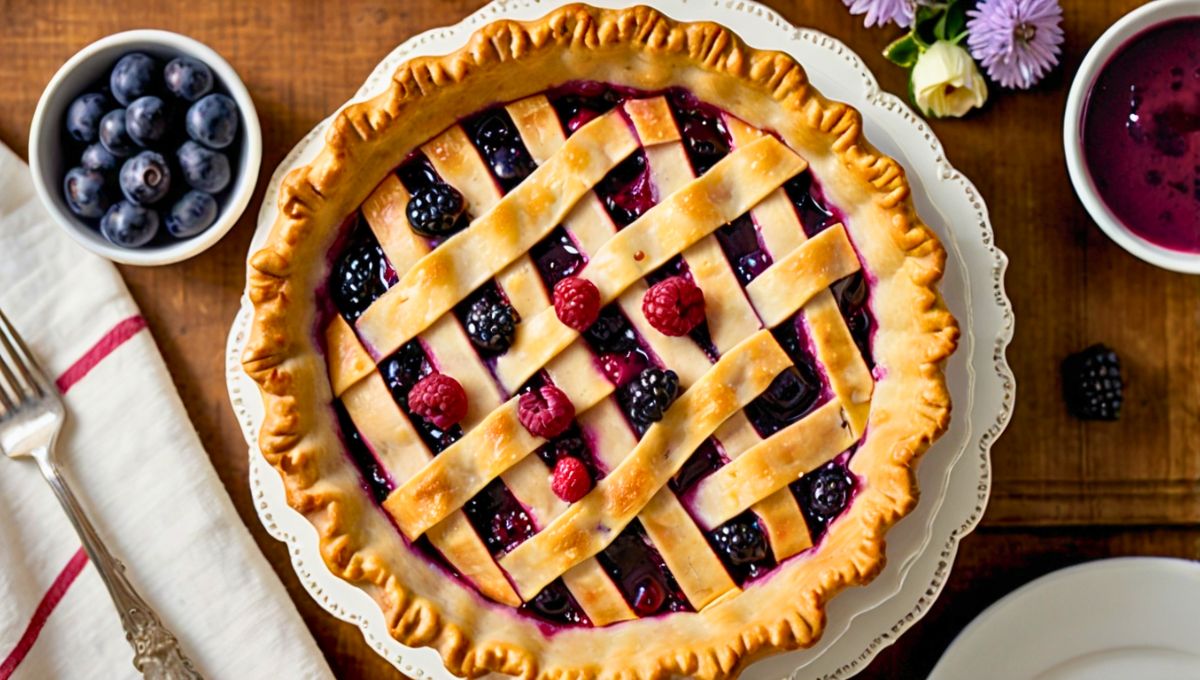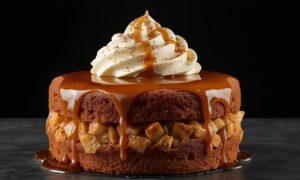There’s something magical about the moment when a Triple Berry Pie Magic Made Easy comes out of the oven bubbling with juices and filling the kitchen with a sweet, fruity aroma. I’ve spent twenty years perfecting this pie, and trust me, nothing gets people to the table faster. The mix of raspberries, blackberries, and blueberries creates a sweet tart blend that bursts with flavor in every bite.
Triple Berry Pie Magic Made Easy isn’t just a dessert, it’s a slice of American tradition that celebrates summer. Whether it’s a picnic, a holiday, or a weeknight treat, this pie turns any moment into something special. The golden crust, juicy berries, and nostalgic charm make it unforgettable.
What makes this recipe stand out is how it balances flavor and structure. It lets the berries shine but holds everything together, no soggy crusts here. We’ll look at the best thickeners, how to build a perfect lattice, and smart tips that take your pie from good to award worthy.
Ingredients & Substitutions
For the Crust:
- 2½ cups all purpose flour
- 1 tablespoon granulated sugar
- 1 teaspoon salt
- 1 cup cold unsalted butter, cubed
- ¼ to ½ cup ice water
- 1 tablespoon apple cider vinegar
- 1 egg (for egg wash)
- 2 tablespoons coarse sugar for topping
For the Filling:
- 2 cups fresh blueberries
- 2 cups fresh raspberries
- 2 cups fresh blackberries
- ¾ cup granulated sugar (adjust based on berry sweetness)
- ¼ cup cornstarch
- 2 tablespoons tapioca flour
- Zest and juice of one lemon
- ¼ teaspoon cinnamon
- Pinch of salt
- 1 tablespoon butter, cut into small pieces
The flour selection matters tremendously in pie dough. I prefer King Arthur all purpose flour for its consistent protein content (around 11.7%), which creates the perfect balance of tenderness and structure. For those with gluten concerns, Bob’s Red Mill 1 to 1 Baking Flour works surprisingly well, though you’ll want to add an extra tablespoon of butter to compensate for absorption differences.
Fresh berries are non negotiable for optimal flavor, but frozen berries can work in a pinch. The key is not to thaw them before mixing, which prevents excessive juice release that leads to soupy filling. Wild berries offer more complex flavor profiles than cultivated varieties, but they’re smaller and require more cleaning time.
My secret ingredient? That tablespoon of apple cider vinegar in the crust. It inhibits gluten development, ensuring your crust stays tender, and the acidity evaporates during baking leaving zero vinegar taste.
Step by Step Instructions
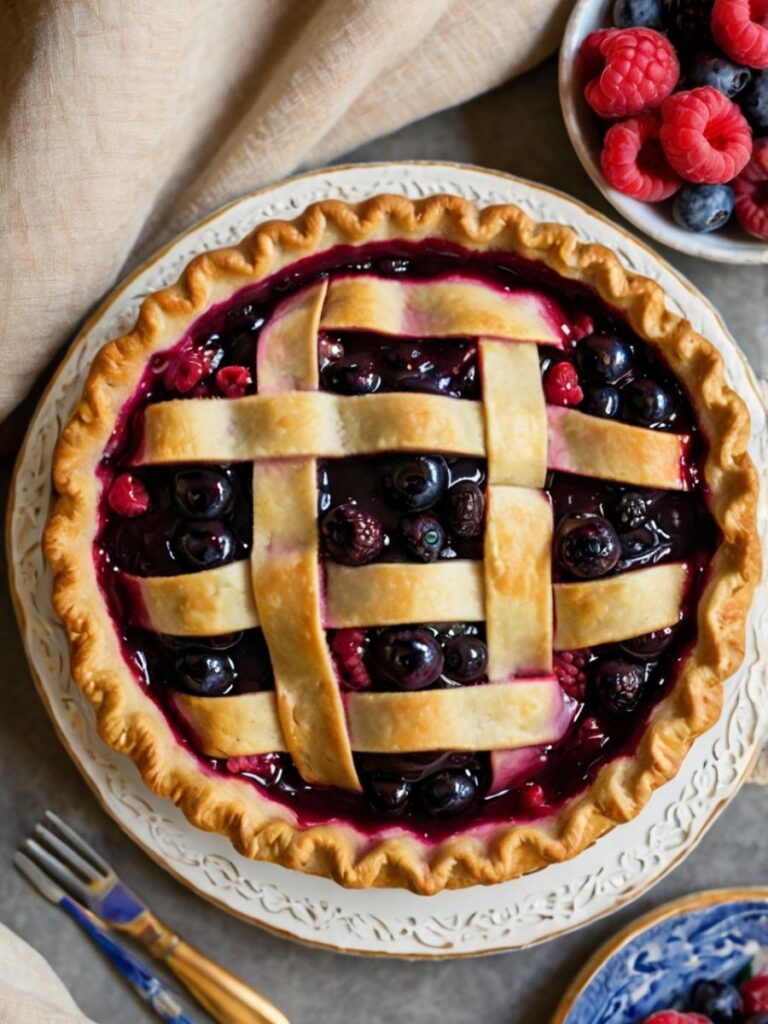
Making the Perfect Pie Dough
- Combine flour, sugar, and salt in a large bowl or food processor.
- Add cold butter cubes and pulse or use a pastry cutter until the mixture resembles coarse meal with some pea sized pieces remaining. Don’t overwork it those butter pockets create flaky layers.
- Combine ice water and apple cider vinegar, then drizzle over the flour mixture, 1 tablespoon at a time. Mix just until the dough comes together when pinched.
Most home bakers overwork their dough, which activates gluten and creates a tough crust. Stop mixing the moment your dough holds together when pressed between your fingers. And for heavens sake, don’t skip the chilling time! At least 1 hour in the fridge allows the gluten to relax and the butter to resolidify.
After chilling, divide the dough into two pieces (one slightly larger for the bottom crust) and roll them out on a lightly floured surface. The thickness should be about ⅛ inch, thin enough to cook through but thick enough to support your filling.
Preparing the Berry Filling
- In a large bowl, gently toss all berries with sugar, cornstarch, tapioca flour, lemon zest, lemon juice, cinnamon, and salt.
- Let the mixture sit for 15-20 minutes to allow the berries to release some juice and the thickeners to hydrate.
- Taste and adjust sweetness if necessary, remember that different berry varieties have dramatically different sweetness levels.
The dual thickener approach might seem fussy, but there’s science behind it. Cornstarch provides body while tapioca adds a glossy, jewel like quality to the filling. Cornstarch alone can become cloudy, while tapioca alone can be too gelatinous. Together, they create the perfect consistency.
A common mistake is adding the filling immediately after mixing. That 15 minute rest period is crucial it allows the thickeners to hydrate and the berries to release juices, preventing a filling that’s either too loose or too stiff after baking.
Assembly and Baking
- Preheat your oven to 425°F (220°C) with a baking sheet inside.
- Line a 9-inch pie dish with the larger dough circle, leaving a slight overhang. Add the filling and dot with small pieces of butter.
- For a lattice top, cut the remaining dough into strips and weave them over the filling. Alternatively, place the whole top crust over the pie and cut decorative vents.
The butter dots on top of the filling might seem like a fussy extra step, but they melt during baking, creating pockets of richness that elevate the entire pie. Trust me, don’t skip this step!
- Trim excess dough, tuck edges under, and crimp decoratively. Brush with egg wash and sprinkle with coarse sugar.
- Place pie on the preheated baking sheet and bake at 425°F for 25 minutes. Then reduce temperature to 375°F (190°C) and continue baking for 30-35 minutes until golden and bubbling.
- Cool completely (at least 3 hours) before slicing to allow the filling to set.
The initial high temperature setting helps “set” the crust quickly, preventing sogginess, while the lower temperature ensures the filling cooks through without burning the crust. Many recipes skip this dual temperature approach, but it’s essential for professional results.
Cooking Techniques & Science
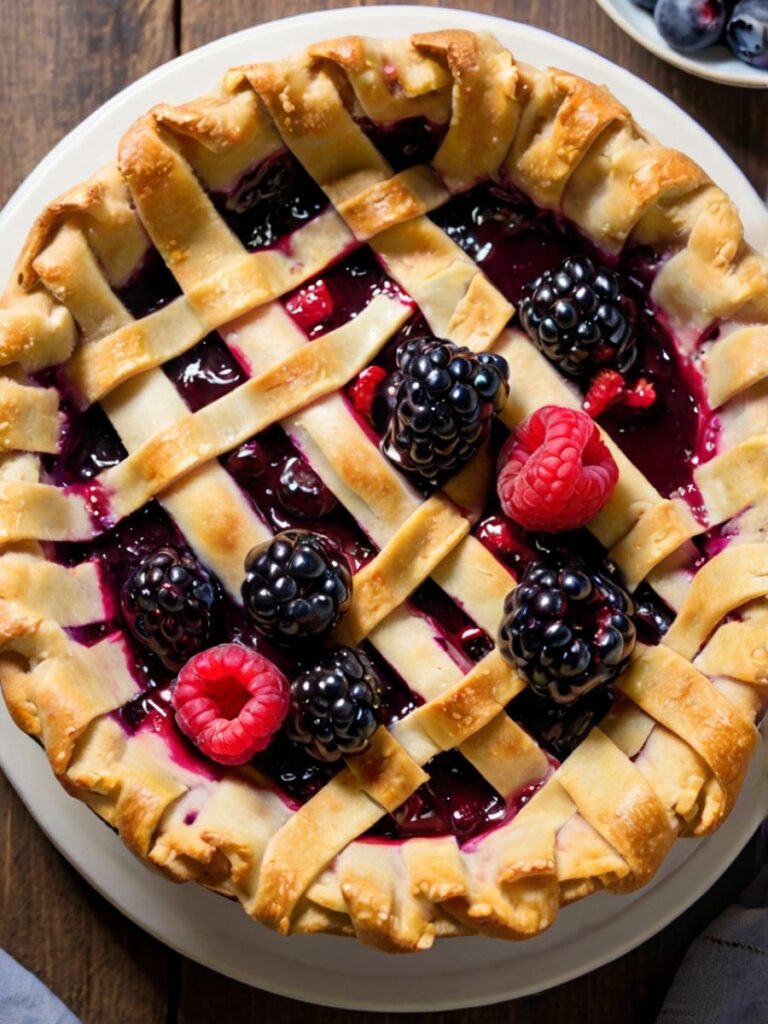
The perfect Triple Berry Pie requires understanding several critical techniques. First, let’s talk about the “cold ingredients” principle. Everything, the flour, butter, water, even the bowl if possible, should be cold when making pie dough. Why? Butter needs to remain in solid pieces throughout the dough to create those flaky layers we crave. When these cold butter pieces hit the hot oven, they create steam pockets, which translate to flakiness.
The ratio of thickener to fruit is another scientific balancing act. Berries contain pectin (a natural thickener), but the amount varies by berry type and ripeness. Blueberries contain more pectin than raspberries or blackberries, which is why the combination of berries requires careful thickening adjustment. My combination of cornstarch and tapioca creates a filling that holds its shape when cut but remains juicy enough to flow slightly.
Lattice crusts aren’t just decorative, they serve a crucial purpose. The gaps allow steam to escape during baking, preventing the dreaded “dome effect” where the top crust rises and creates an air pocket. For berries with high moisture content, this steam release is essential for proper cooking.
One technique that separates amateur pies from professional ones is blind baking or in this case, not blind baking. Unlike custard pies, berry pies actually benefit from simultaneous crust and filling cooking. The bottom crust absorbs just enough fruit juice to create a tender firm texture without becoming soggy.
The cooling period is perhaps the most underappreciated technical aspect of pie making. Cutting into a hot pie ruins the structure the thickeners haven’t had time to fully set. Patience yields perfect slices with filling that holds its shape rather than running all over the plate.
Serving & Pairing Suggestions
A properly cooled Triple Berry Pie should be served at room temperature or slightly warmed (about 10 minutes in a 200°F oven), never hot from the oven and never cold from the refrigerator. Temperature dramatically affects flavor perception; cold temperatures suppress sweetness and dull the delicate berry notes.
For plating, use a sharp knife dipped in hot water between cuts for clean slices. A pie server with a slightly serrated edge will help lift slices without damaging the bottom crust.
While vanilla ice cream is the classic accompaniment (and rightfully so, the creamy vanilla notes complement the tart berries beautifully), consider some less conventional pairings. A dollop of mascarpone cheese whipped with a touch of honey brings sophisticated creaminess. A small glass of Sauternes or late harvest Riesling echoes the sweetness while adding complex notes.
For a truly memorable dessert experience, I like to serve Triple Berry Pie with a trio of accompaniments: classic vanilla bean ice cream, lemon infused whipped cream, and a drizzle of aged balsamic reduction. The acid in the balsamic magnificently heightens the berry flavors while adding depth.
Leftover pie (if such a thing exists) makes an indulgent breakfast when paired with fresh ricotta or Greek yogurt. The protein balances the sweetness, making it almost respectable as a morning meal.
Seasonal Variations
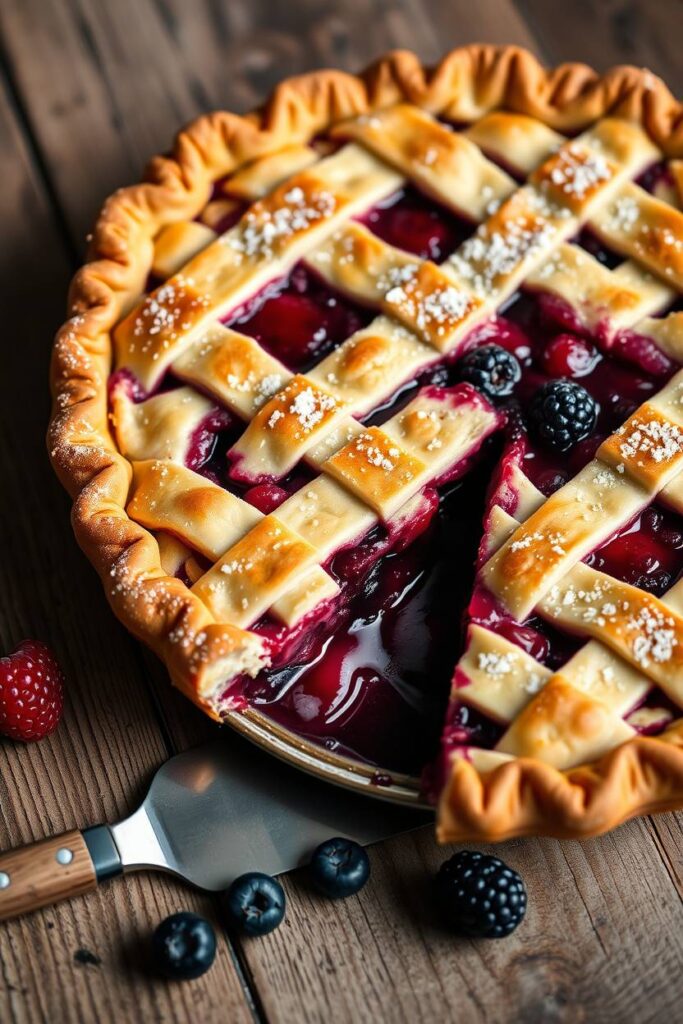
While summer offers peak berry season, this pie can be adapted year round. In winter, I supplement limited fresh berries with dried cherries rehydrated in brandy. The complexity they add is unbelievable.
Spring berries tend to be more tart, so you might increase the sugar by 2-3 tablespoons. Late summer berries are sweeter and may need an extra squeeze of lemon juice to balance flavors.
For a holiday variation, add a cinnamon stick and star anise to the filling mixture and let it infuse for 30 minutes (remove before baking). The subtle spice notes evoke winter comfort while maintaining the pie’s essential character.
Fall’s cooler temperatures call for warming the serving plates slightly before plating. The subtle temperature contrast between the room temperature pie and warm plate enhances the aromatic compounds, making the flavor experience even more intense.
Troubleshooting Common Issues
If your filling bubbles over during baking (a common problem with berry pies), you’ve likely overfilled your pie or haven’t created adequate vents. Next time, leave at least ½ inch headspace below the top crust. And always, always bake berry pies on a rimmed baking sheet to catch potential drips.
Soggy bottom crust plagues many bakers. Beyond the preheated baking sheet trick mentioned earlier, consider sprinkling a tablespoon of ground almonds or fine cookie crumbs over the bottom crust before adding filling. This creates a moisture barrier without affecting flavor.
If your lattice strips break when you’re weaving them, your dough is either too warm or too dry. Return it to the refrigerator for 15 minutes, or if it’s dry, sprinkle a few drops of ice water and gently work it in before trying again.
Dark spots on your crust before the filling is properly cooked indicate your oven temperature is too high or unevenly heated. Use aluminum foil strips or a pie shield to protect the edges, and consider getting an oven thermometer to check your oven’s accuracy.
Conclusion
Triple Berry Pie Magic Made Easy represents the perfect blend of technique and quality ingredients. The crisp, flaky crust paired with the juicy berry filling creates a delicious contrast in every bite. What makes this version stand out is its scientific precision, from balanced thickeners to proper oven temperature and the ideal berry mix.
After baking hundreds of berry pies, I’ve learned that success comes from respecting the ingredients and knowing how they work together. The methods shared here, like using two thickeners and staging temperatures, turn a simple pie into something unforgettable.
Whether it’s for a special event or a quiet summer afternoon, Triple Berry Pie Magic Made Easy brings both comfort and elegance to the table. Once you master this recipe, you’ll never look for another berry pie again.
FAQs
Can I make this pie ahead of time?
Yes! Dough can be refrigerated (3 days) or frozen (1 month). Unbaked assembled pies freeze for up to 2 months, bake directly from frozen, adding 15 minutes. Fully baked pies keep at room temperature for 2 days or refrigerated for 5 days.
Why is my filling runny?
Common causes: underbaking (needs 5-7 minutes of vigorous bubbling) or cutting before cooling completely (minimum 3 hours). Both properly activate and set the thickeners.
Can I use strawberries?
Not recommended due to higher water content and different texture. If necessary, limit to 25% of total berries, slice thinly, and add 1 extra teaspoon of thickener.
How do I get that shiny filling?
The tapioca flour helps. For extra shine, brush exposed filling through lattice with 1 tablespoon warmed apricot jam thinned with 1 teaspoon water after slight cooling.
Why does my crust shrink?
Typically from overworked gluten or stretched dough. Mix minimally, allow proper refrigeration time, and lay dough in pan without stretching.

Swiftly Captions by Tina Smith — Quick, flavorful food recipes made simple, bringing fresh inspiration to your kitchen every day
